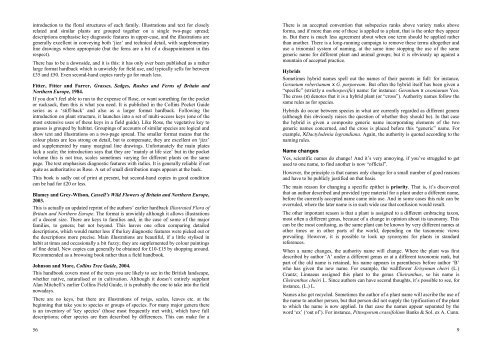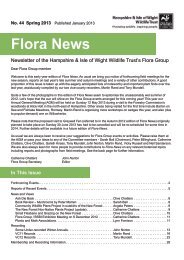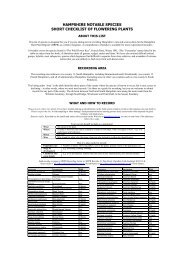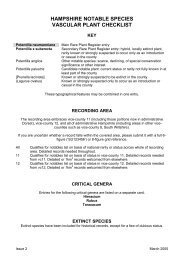An A5 booklet version as distributed in the - Hants Plants
An A5 booklet version as distributed in the - Hants Plants
An A5 booklet version as distributed in the - Hants Plants
Create successful ePaper yourself
Turn your PDF publications into a flip-book with our unique Google optimized e-Paper software.
<strong>in</strong>troduction to <strong>the</strong> floral structures of each family. Illustrations and text for closely<br />
related and similar plants are grouped toge<strong>the</strong>r on a s<strong>in</strong>gle two-page spread;<br />
descriptions emph<strong>as</strong>ise key diagnostic features <strong>in</strong> upper-c<strong>as</strong>e, and <strong>the</strong> illustrations are<br />
generally excellent <strong>in</strong> convey<strong>in</strong>g both ‘jizz’ and technical detail, with supplementary<br />
l<strong>in</strong>e draw<strong>in</strong>gs where appropriate (but <strong>the</strong> ferns are a bit of a disappo<strong>in</strong>tment <strong>in</strong> this<br />
respect).<br />
There h<strong>as</strong> to be a downside, and it is this: it h<strong>as</strong> only ever been published <strong>as</strong> a ra<strong>the</strong>r<br />
large format hardback which is unwieldy for field use, and typically sells for between<br />
£35 and £50. Even second-hand copies rarely go for much less.<br />
Fitter, Fitter and Farrer, Gr<strong>as</strong>ses, Sedges, Rushes and Ferns of Brita<strong>in</strong> and<br />
Nor<strong>the</strong>rn Europe, 1984.<br />
If you don’t feel able to run to <strong>the</strong> expense of Rose, or want someth<strong>in</strong>g for <strong>the</strong> pocket<br />
or rucksack, <strong>the</strong>n this is what you need. It is published <strong>in</strong> <strong>the</strong> Coll<strong>in</strong>s Pocket Guide<br />
series <strong>as</strong> a ‘stiff-back’ and also <strong>as</strong> a larger format hardback. Follow<strong>in</strong>g <strong>the</strong><br />
<strong>in</strong>troduction on plant structure, it launches <strong>in</strong>to a set of multi-access keys (one of <strong>the</strong><br />
most extensive uses of <strong>the</strong>se keys <strong>in</strong> a field guide). Like Rose, <strong>the</strong> vegetative key to<br />
gr<strong>as</strong>ses is grouped by habitat. Group<strong>in</strong>gs of accounts of similar species are logical and<br />
show text and illustrations on a two-page spread. The smaller format means that <strong>the</strong><br />
colour plates are less strong on detail, but to compensate, <strong>the</strong>y are excellent on ‘jizz’<br />
and supplemented by many marg<strong>in</strong>al l<strong>in</strong>e draw<strong>in</strong>gs. Unfortunately <strong>the</strong> ma<strong>in</strong> plates<br />
lack a scale; <strong>the</strong> <strong>in</strong>troduction says that <strong>the</strong>y are ‘ma<strong>in</strong>ly at life size’ but <strong>in</strong> <strong>the</strong> pocket<br />
volume this is not true, scales sometimes vary<strong>in</strong>g for different plants on <strong>the</strong> same<br />
page. The text emph<strong>as</strong>ises diagnostic features with italics. It is generally reliable if not<br />
quite <strong>as</strong> authoritative <strong>as</strong> Rose. A set of small distribution maps appears at <strong>the</strong> back.<br />
This book is sadly out of pr<strong>in</strong>t at present, but second-hand copies <strong>in</strong> good condition<br />
can be had for £20 or less.<br />
Blamey and Grey-Wilson, C<strong>as</strong>sell’s Wild Flowers of Brita<strong>in</strong> and Nor<strong>the</strong>rn Europe,<br />
2003.<br />
This is actually an updated repr<strong>in</strong>t of <strong>the</strong> authors’ earlier hardback Illustrated Flora of<br />
Brita<strong>in</strong> and Nor<strong>the</strong>rn Europe. The format is unwieldy although it allows illustrations<br />
of a decent size. There are keys to families and, <strong>in</strong> <strong>the</strong> c<strong>as</strong>e of some of <strong>the</strong> major<br />
families, to genera; but not beyond. This leaves one often compar<strong>in</strong>g detailed<br />
descriptions, which would matter less if <strong>the</strong> key diagnostic features were picked out or<br />
<strong>the</strong> descriptions more precise. Ma<strong>in</strong> illustrations are beautiful, if a little stylised <strong>in</strong><br />
habit at times and occ<strong>as</strong>ionally a bit fuzzy; <strong>the</strong>y are supplemented by colour pa<strong>in</strong>t<strong>in</strong>gs<br />
of f<strong>in</strong>e detail. New copies can generally be obta<strong>in</strong>ed for £10-£15 by shopp<strong>in</strong>g around.<br />
Recommended <strong>as</strong> a brows<strong>in</strong>g book ra<strong>the</strong>r than a field handbook.<br />
Johnson and More, Coll<strong>in</strong>s Tree Guide, 2004.<br />
This handbook covers most of <strong>the</strong> trees you are likely to see <strong>in</strong> <strong>the</strong> British landscape,<br />
whe<strong>the</strong>r native, naturalised or <strong>in</strong> cultivation. Although it doesn’t entirely supplant<br />
Alan Mitchell’s earlier Coll<strong>in</strong>s Field Guide, it is probably <strong>the</strong> one to take <strong>in</strong>to <strong>the</strong> field<br />
nowadays.<br />
There are no keys, but <strong>the</strong>re are illustrations of twigs, scales, leaves etc. at <strong>the</strong><br />
beg<strong>in</strong>n<strong>in</strong>g that take you to species or groups of species. For many major genera <strong>the</strong>re<br />
is an <strong>in</strong>ventory of ‘key species’ (those most frequently met with), which have full<br />
descriptions; o<strong>the</strong>r species are <strong>the</strong>n described by differences. This can make for a<br />
56<br />
There is an accepted convention that subspecies ranks above variety ranks above<br />
forma, and if more than one of <strong>the</strong>se is applied to a plant, that is <strong>the</strong> order <strong>the</strong>y appear<br />
<strong>in</strong>. But <strong>the</strong>re is much less agreement about when one term should be applied ra<strong>the</strong>r<br />
than ano<strong>the</strong>r. There is a long-runn<strong>in</strong>g campaign to remove <strong>the</strong>se terms altoge<strong>the</strong>r and<br />
use a tr<strong>in</strong>omial system of nam<strong>in</strong>g, at <strong>the</strong> same time stopp<strong>in</strong>g <strong>the</strong> use of <strong>the</strong> same<br />
generic name for different plant and animal groups; but it is obviously up aga<strong>in</strong>st a<br />
mounta<strong>in</strong> of accepted practice.<br />
Hybrids<br />
Sometimes hybrid names spell out <strong>the</strong> names of <strong>the</strong>ir parents <strong>in</strong> full: for <strong>in</strong>stance,<br />
Geranium robertianum x G. purpureum. But often <strong>the</strong> hybrid itself h<strong>as</strong> been given a<br />
“specific” (strictly a nothospecific) name: for <strong>in</strong>stance: Geranium x oxonianum Yeo.<br />
The cross (x) denotes that it is a hybrid plant (or “cross”). Authority names follow <strong>the</strong><br />
same rules <strong>as</strong> for species.<br />
Hybrids do occur between species <strong>in</strong> what are currently regarded <strong>as</strong> different genera<br />
(although this obviously raises <strong>the</strong> question of whe<strong>the</strong>r <strong>the</strong>y should be). In that c<strong>as</strong>e<br />
<strong>the</strong> hybrid is given a composite generic name <strong>in</strong>corporat<strong>in</strong>g elements of <strong>the</strong> two<br />
generic names concerned, and <strong>the</strong> cross is placed before this “generic” name. For<br />
example, XDactylodenia legrandiana. Aga<strong>in</strong>, <strong>the</strong> authority is quoted accord<strong>in</strong>g to <strong>the</strong><br />
nam<strong>in</strong>g rules.<br />
Name changes<br />
Yes, scientific names do change! <strong>An</strong>d it’s very annoy<strong>in</strong>g, if you’ve struggled to get<br />
used to one name, to f<strong>in</strong>d ano<strong>the</strong>r is now “official”.<br />
However, <strong>the</strong> pr<strong>in</strong>ciple is that names only change for a small number of good re<strong>as</strong>ons<br />
and have to be publicly justified on that b<strong>as</strong>is.<br />
The ma<strong>in</strong> re<strong>as</strong>on for chang<strong>in</strong>g a specific epi<strong>the</strong>t is priority. That is, it’s discovered<br />
that an author described and provided type material for a plant under a different name,<br />
before <strong>the</strong> currently accepted name came <strong>in</strong>to use. <strong>An</strong>d <strong>in</strong> some c<strong>as</strong>es this rule can be<br />
overruled, where <strong>the</strong> later name is <strong>in</strong> such wide use that confusion would result.<br />
The o<strong>the</strong>r important re<strong>as</strong>on is that a plant is <strong>as</strong>signed to a different embrac<strong>in</strong>g taxon,<br />
most often a different genus, because of a change <strong>in</strong> op<strong>in</strong>ion about its taxonomy. This<br />
can be <strong>the</strong> most confus<strong>in</strong>g, <strong>as</strong> <strong>the</strong> same plant can be known by very different names at<br />
o<strong>the</strong>r times or <strong>in</strong> o<strong>the</strong>r parts of <strong>the</strong> world, depend<strong>in</strong>g on <strong>the</strong> taxonomic views<br />
prevail<strong>in</strong>g. However, it is possible to look up synonyms for plants <strong>in</strong> standard<br />
references.<br />
When a name changes, <strong>the</strong> authority name will change. Where <strong>the</strong> plant w<strong>as</strong> first<br />
described by author ‘A’ under a different genus or at a different taxonomic rank, but<br />
part of <strong>the</strong> old name is reta<strong>in</strong>ed, his name appears <strong>in</strong> paren<strong>the</strong>ses before author ‘B’<br />
who h<strong>as</strong> given <strong>the</strong> new name. For example, <strong>the</strong> wallflower Erisymum cheiri (L.)<br />
Crantz; L<strong>in</strong>naeus <strong>as</strong>signed this plant to <strong>the</strong> genus Cheiranthus, so his name is<br />
Cheiranthus cheiri L. S<strong>in</strong>ce authors can have second thoughts, it’s possible to see, for<br />
<strong>in</strong>stance, (L.) L.<br />
Names also get recycled. Sometimes <strong>the</strong> author of a plant name will <strong>as</strong>cribe <strong>the</strong> use of<br />
<strong>the</strong> name to ano<strong>the</strong>r person, but that person did not supply <strong>the</strong> typification of <strong>the</strong> plant<br />
to which <strong>the</strong> name is now applied. In that c<strong>as</strong>e <strong>the</strong> names appear separated by <strong>the</strong><br />
word ‘ex’ (‘out of’). For <strong>in</strong>stance, Pittosporum cr<strong>as</strong>sifolium Banks & Sol. ex A. Cunn.<br />
9







